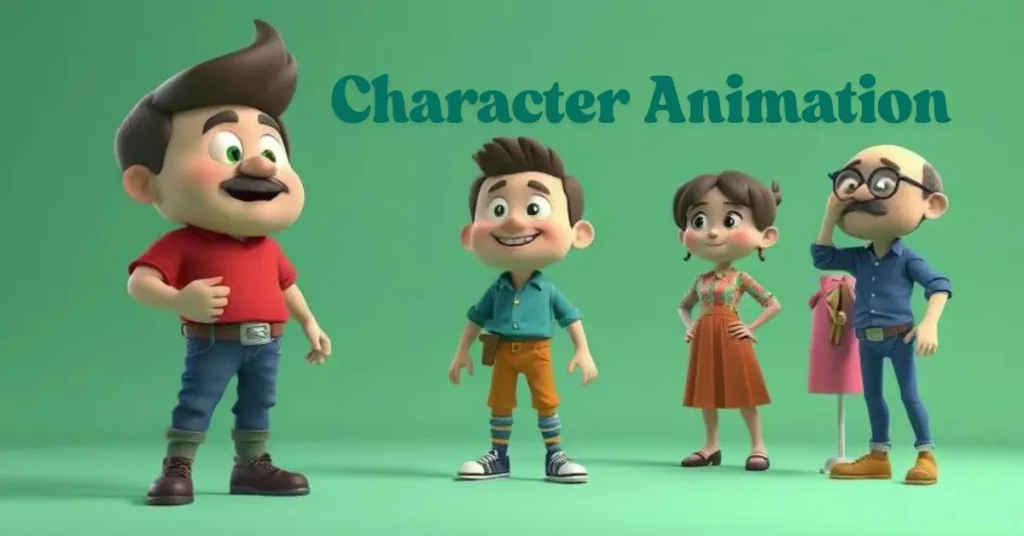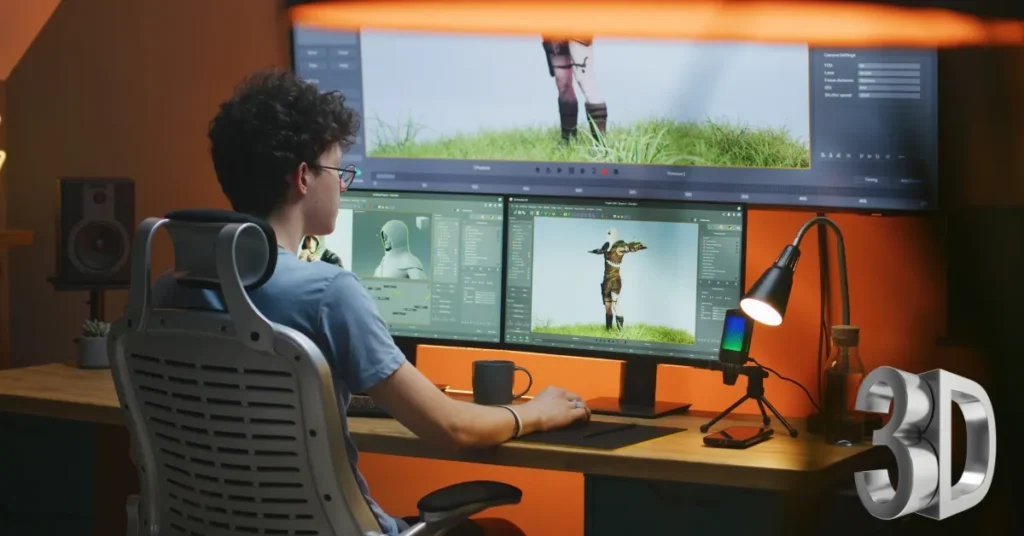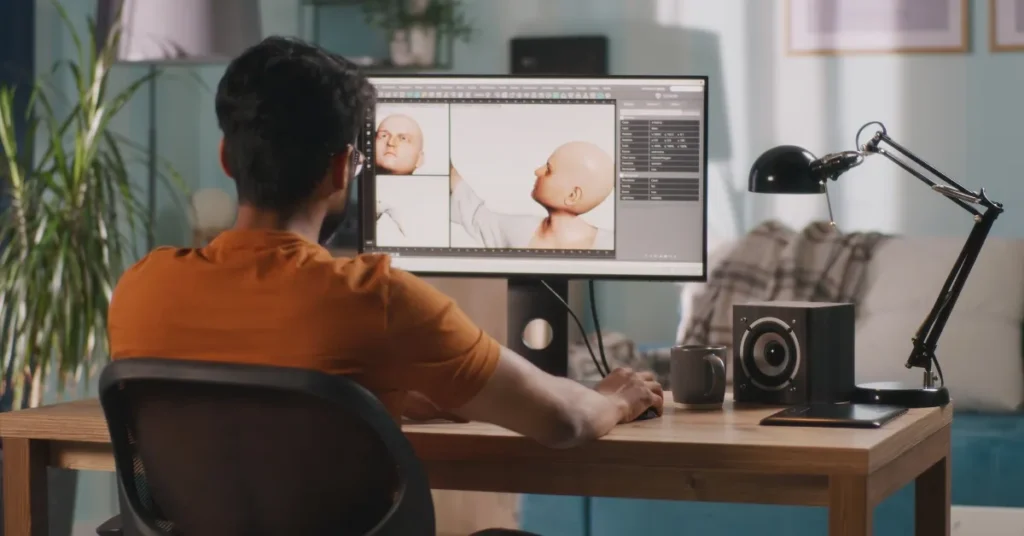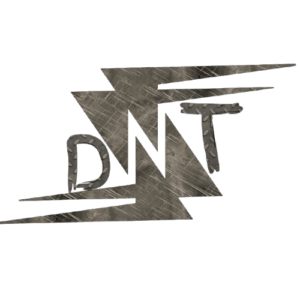Character animation is the heart of bringing stories to life.
But let’s be real – getting it right can feel like wrestling a bear.
How do you make characters move naturally?
How do you avoid that creepy, robotic vibe?
I’ve been there, staring at a screen, wondering why my character looks like it’s sleepwalking.
Here’s the deal: I’m breaking down character animation so it’s dead simple.
No fluff, just the stuff that works.

What Is Character Animation, Anyway?
It’s breathing life into digital characters.
Think Woody in Toy Story or your favourite game hero dodging bullets.
It’s not just moving pixels – it’s making them feel human (or alien, or dragon, you get it).
I remember my first attempt – my character’s arm flopped like a wet noodle.
Learned the hard way: it’s all about timing, flow, and emotion.
Character animation covers:
- 2D animation: Classic, hand-drawn vibes like old-school Disney.
- 3D animation: Think Pixar or video games with depth and realism.
- Stop-motion: Quirky, tangible charm like Wallace and Gromit.
- Motion capture: Real human moves mapped to digital characters, like Gollum in Lord of the Rings.
Each has its flavour, but the goal’s the same: make it believable.
Why Character Animation Matters
It’s not just pretty visuals.
Great character animation hooks your audience.
Ever cried watching an animated film?
That’s animation flexing its muscles.
It builds connections, drives stories, and sells products.
I once saw a simple animated mascot boost a brand’s engagement by 40%.
No joke – people bond with characters that move right.
It’s huge for:
- Films and games: Immersive worlds need characters that pop.
- Marketing: Animated ads grab attention faster than static ones.
- Education: Animated characters make boring topics fun (think Duolingo’s owl).
How to Crush Character Animation
I’m not here to bore you with theory.
Here’s how I approach character animation to get results fast.
1. Nail the Basics First
Start with the fundamentals.
No shortcuts here.
- Timing and spacing: Make movements feel natural – slow starts, quick stops.
- Squash and stretch: Add bounce to show weight (think a cartoon ball).
- Arcs: Humans don’t move in straight lines – curve those motions.
I once animated a dog wagging its tail.
Forgot arcs.
Looked like a metronome.
Fixed it by studying real dogs – boom, instant charm.
2. Plan Like a Pro
Don’t just wing it.
- Storyboards: Sketch the scene to map emotions and actions.
- Reference videos: Record yourself acting it out (yes, you’ll feel silly, but it works).
- Thumbnails: Quick doodles to nail key poses.
Pro tip: I use my phone to film quirky moves for reference.
Saves hours of guesswork.
3. Pick the Right Tools
You don’t need a fat wallet to start.
I’ll dive into the best free and paid tools for character animation later, but the key is matching the tool to your project.
Free ones like Blender are beasts for 3D.
Paid ones like Adobe Animate shine for polished 2D workflows.
4. Make Characters Feel Alive
This is where character animation shines.
Focus on emotion.
- Eyes: They’re the soul. Slight tilts scream joy or fear.
- Micro-movements: A lip twitch or shoulder shrug adds depth.
- Exaggeration: Push poses for impact (but don’t overdo it).
Example: I gave a character a nervous foot tap.
Audience ate it up – felt real without saying a word.
5. Test and Tweak
Render early, render often.
Spot glitches before you’re too deep.
I once skipped this and spent a week fixing a wonky walk cycle.
Never again.

2D vs. 3D Character Animation: What’s the Deal?
Both are awesome, but they’re not twins.
2D feels artsy, nostalgic.
Think SpongeBob – flat but bursting with personality.
It’s faster for simple projects.
3D screams realism and depth.
Think Spider-Verse – complex but immersive.
It’s heavier on tech and time.
I lean 2D for quick marketing gigs.
3D for games where players need to feel in the world.
Pick based on your vibe and deadline.
Best Free and Paid Tools for Character Animation
Here’s the meat: the best tools to make your character animation pop.
I’ve used these myself, so I’m not just guessing.
Let’s break down free and paid options, with pros, cons, and prices (in dollars, where available).
Free Tools for Character Animation
1. Blender
What it does: Open-source 3D animation suite with killer character animation features.
Price: $0 (completely free).
Pros:
- Full pipeline: modelling, rigging, animation, rendering – all in one.
- Insane community support with tutorials galore.
- Handles 2D and 3D like a champ.
- Physics-based tools for realistic movements.
Cons:
- Steep learning curve – feels like climbing Everest at first.
- Interface can overwhelm newbies.
- Not as streamlined for 2D as dedicated tools.
My take: I animated a robot in Blender for free. Took a week to learn, but the result was pro-level. Perfect for 3D character animation on a budget.
2. Krita
What it does: Free 2D animation and digital painting software.
Price: $0 (donations encouraged).
Pros:
- Smooth drawing tools – feels like sketching on paper.
- Frame-by-frame animation for that classic vibe.
- Lightweight, runs on modest PCs.
- Great for storyboarding too.
Cons:
- Limited rigging compared to 3D tools.
- No advanced 3D support.
- Smaller community than Blender.
My take: Used Krita for a 2D cartoon cat. Super intuitive for hand-drawn character animation.
3. Synfig Studio
What it does: Free 2D vector-based animation software with bone rigging.
Price: $0 (open-source).
Pros:
- Bone system for easy character rigging.
- Vector tweening cuts manual work.
- Over 50 layer types for complex scenes.
- Cross-platform (Windows, Mac, Linux).
Cons:
- Buggy at times – save often.
- Steeper learning curve for rigging.
- Not ideal for 3D or super-polished projects.
My take: Synfig’s bone system saved me hours on a puppet-style animation. Great for 2D character animation if you don’t mind quirks.

4. OpenToonz
What it does: Free 2D animation software used by Studio Ghibli.
Price: $0 (open-source).
Pros:
- Pro-grade tools for frame-by-frame animation.
- Scanning for hand-drawn art.
- Plugins for extra effects.
- Trusted by top studios.
Cons:
- Clunky interface – feels dated.
- Setup can be a hassle.
- Limited 3D capabilities.
My take: Tried OpenToonz for a Ghibli-inspired short. Felt like a time machine, but the results were gorgeous for 2D character animation.
5. Pencil2D
What it does: Ultra-simple 2D animation for hand-drawn projects.
Price: $0 (open-source).
Pros:
- Dead simple – perfect for beginners.
- Supports raster and vector graphics.
- Lightweight, no beefy PC needed.
- Cross-platform.
Cons:
- Bare-bones features – no rigging or advanced tools.
- Not for complex projects.
- Limited export options.
My take: Animated a bouncing ball in an hour with Pencil2D. Ideal for newbies dipping into 2D character animation.

Paid Tools for Character Animation
1. Adobe Animate
What it does: Industry-standard 2D animation for web, games, and cartoons.
Price: $22.99/month (annual plan) or $239.88/year.
Pros:
- Seamless Adobe ecosystem integration (Photoshop, Illustrator).
- Vector-based for crisp animations.
- HTML5 and WebGL export for web and mobile.
- Lip-syncing and rigging tools.
Cons:
- Subscription model adds up.
- Not ideal for 3D animation.
- Learning curve for advanced features.
My take: Used Animate for a web ad with a dancing mascot. Polished and fast, but I hate subscriptions. Top-tier for 2D character animation.
2. Autodesk Maya
What it does: Pro-level 3D animation used by Disney and Pixar.
Price: $2479/year or $315/month (flexible plans available).
Pros:
- Unreal rigging and animation tools – think Quick Rig for bipeds.
- Hyper-realistic character animation.
- Massive plugin library.
- Industry standard for films and games.
Cons:
- Crazy expensive for solo artists.
- Steep learning curve – weeks to feel comfy.
- Overkill for simple 2D projects.
My take: Animated a dragon in Maya for a game pitch. Jaw-dropping results, but my wallet cried. Best for pro 3D character animation.
3. Toon Boom Harmony
What it does: Premium 2D animation for TV shows like The Simpsons.
Price: $29/month (Essentials), $77/month (Advanced), $138/month (Premium).
Pros:
- Pro-grade 2D rigging and cut-out animation.
- Vector and bitmap support.
- Used by major studios – battle-tested.
- Imports Photoshop and Illustrator files.
Cons:
- Pricey for hobbyists.
- Complex for beginners.
- Not suited for 3D animation.
My take: Did a TV pilot with Harmony. Felt like driving a Ferrari for 2D character animation, but it’s not cheap.
4. Cartoon Animator 5
What it does: 2D animation with easy rigging and motion templates.
Price: $199 (one-time perpetual license).
Pros:
- No subscription – pay once, own it.
- Pre-designed characters and motions speed things up.
- Webcam facial animation for quick lip-sync.
- Great for beginners and pros.
Cons:
- Add-ons cost extra.
- Less flexible than Harmony or Animate for custom work.
- 2D only – no 3D support.
My take: Used it for a YouTube short. Rigged a character in an hour – super fast for 2D character animation.
5. Cinema 4D
What it does: 3D animation with a focus on motion graphics and characters.
Price: $81.91/month (annual plan) or $983/year (Maxon One bundle at $149.91/month).
Pros:
- Intuitive interface – easier than Maya for newbies.
- Killer tools for character animation and VFX.
- Seamless Adobe After Effects integration.
- Great for motion graphics.
Cons:
- Expensive for solo creators.
- Not as deep as Maya for complex rigging.
- Subscription can sting.
My take: Animated a 3D mascot for a brand. Smoother than Maya for quick projects, but still pricey for character animation.
Real-World Example: My First Character Animation Win
The first project was a dancing cat for a local ad.
I used Krita (free), studied cat videos, and leaned hard into squash-and-stretch.
Nailed the goofy vibe.
Client loved it, and it went viral locally.
Proof: keep it simple, make it fun.
FAQs About Character Animation
What’s the easiest way to start character animation?
Grab a free tool like Blender or Pencil2D.
Start with a bouncing ball to learn timing.
Build from there.
Do I need to be good at drawing?
Nope.
3D animation leans on tools, not sketches.
2D needs some art skills, but you can learn as you go.
How long does it take to animate a character?
Depends.
A 10-second 2D clip might take a day.
3D with rigging? Maybe a week.
Practice speeds you up.
What’s better: 2D or 3D animation?
Neither’s better – it’s about your goal.
2D for quick, artsy stuff.
3D for immersive, polished projects.
Can I do character animation for free?
100%.
Blender, Krita, Synfig, and OpenToonz are free and legit.
No excuses.
What’s the best free tool for beginners?
Pencil2D for 2D – dead simple.
Blender for 3D – if you’ve got patience.
Are paid tools worth it?
If you’re going pro, yes.
Maya and Harmony are industry kings for a reason.
For hobbyists, free tools like Blender often do enough.
Know More
Want to dig deeper?
Check out more gems from daytalk.in.
Character animation isn’t rocket science.
It’s about practice, tools, and a bit of heart.
So grab Blender, mess around, and make something that moves you.
You got this.

